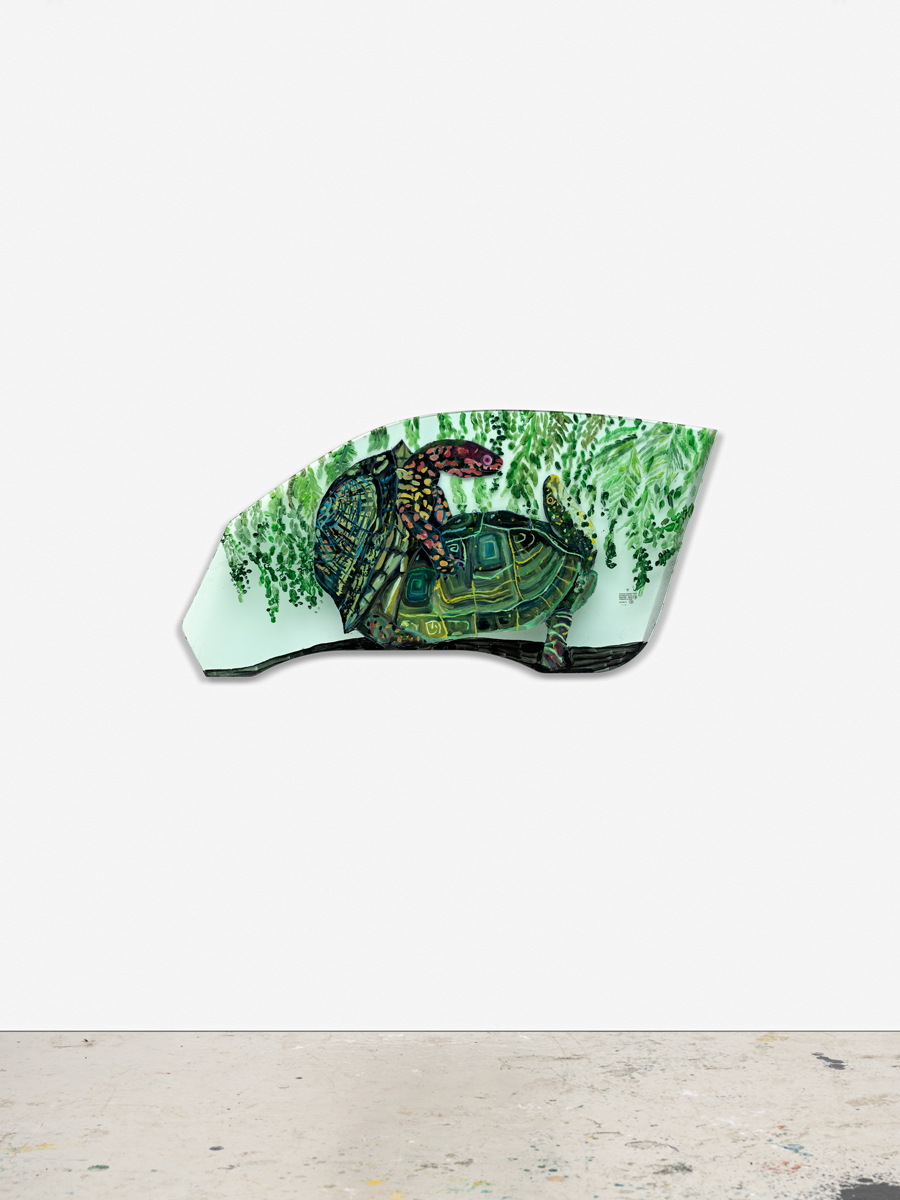Jill Mulleady's Disembodied Porsche Windows Find Their Way Home
At Schloss, Oslo – located in a former Porsche workshop – car windows becomes canvases for mystical scenes of origins and afterlives
At Schloss, Oslo – located in a former Porsche workshop – car windows becomes canvases for mystical scenes of origins and afterlives

I doubt there are many shows that are more explicitly site-specific than Jill Mulleady’s solo exhibition, ‘Void of Course’, at Schloss. The Los Angeles-based artist has collected Porsche windows, the backsides of which she has painted with a view towards the front – so that the first strokes do not make up the bottom layers but the top – with pictures inspired by art history, television shows and nature photography, amongst other things. Schloss, for those of you who don’t know, is located in a former Porsche workshop.
Site-specificity means something different here. For one, Mulleady’s windows are site-specific by way of a detour: they were transported to the gallery from elsewhere and with a newfound purpose. A genius loci, that is, the original genius loci, is therefore invoked via a displacement: authenticity is found in decontextualized repetition – in simulacra. Another variation on the theme is driven home – or rather, away – by the exhibition’s title. ‘Void of Course’, as the poetic and insightful press statement explains, is an ‘astrological term for the moon’s passage between one sign of the zodiac and the next […] a transitional moment of drifting autonomy’. What this suggests, amongst other things, is that these windows are in transition – or bearing witness to it. Indeed, these impressionistic paintings – depicting eels and octopuses, clinking skulls, a witch’s lair, a Viking, a horse’s face, colourful carafes and copulating turtles – call to mind a mystical journey, similar to that which a child might experience from the backseat of a car, as they watch the world pass by and allow their mind to wander.

Mulleady’s windows are so far removed from their original sites and situations that it is unclear whether they have been reworked. Installed next to one another on the gallery walls and painted in bright, thick, purposely imperfect, expressive strokes, the objects do not resemble car windows so much as archaeological finds of a lost, incomprehensible civilization; isolated fragments of distant wholes, the rhyme or reason of which passes us by.
Of the eight windows, the side panel entitled Solus Locus (2018), which features an oversized mollusc touched by a gloved hand, seems to be a crucial piece of Mulleady’s unsolvable puzzle. The title and subject matter are perhaps a reference to Raymond Roussel’s novel Locus Solus (1914) – in which molluscs frequently feature – a text that might prove important to the exhibition as a whole. In Locus Solus, the madman inventor Martial Canterel installs eight glass partitions in his rarity cabinet, behind which he stages tableaux vivants of the living dead in order to eternally re-enact moments from their past. Each of these encased creatures – to return to the idiom of the press release, ‘drifting autonomously’ – is both visible to and distanced from us, the glass an physical boundary as well as an ontological border. They are held at an ‘impossible distance’, as Michel Foucault calls it in Death and the Labyrinth (1963), his text on Roussel.

In ‘Void of Course’, Mulleady resurrects the Porsche workshop by re-inserting car windows in the same manner that Canterel resurrects his dead subjects. In both cases, formal repetition and simulacra are employed in a way that further distances the very myth of origin that is repeated. Yet, at the same time, it is precisely through this artificiality that a series of alternate realities enter our purview, since each insertion injects traces of its own past, each repetition its own context, each simulacrum its own distinct logic. In ‘Void of Course’, each of the windows opens onto a journey and ontic realm of its own, which in turn plunges the gallery space into the eye of a narrative and ontological tornado – a virtual high-speed drive-by across multiple worlds.
Jill Mulleady, ‘Void of Course’ runs at Schloss, Oslo until 11 August.
Main image: Jill Mulleady, Lagertha, 2018, enamel on Porsche windshield, 46 × 74 cm. Courtesy: the artist and Schloss, Oslo; photograph: Vegard Kleven





















